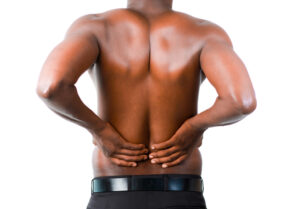Lumbar (lower back) muscle strains and sprains are the most common causes of low back pain.
 The back is prone to this strain because of its weight-bearing function and involvement in moving, twisting and bending. Lumbar muscle strain is caused when muscle fibers are abnormally stretched or torn. Lumbar sprain is caused when ligaments, the tough bands of tissue that hold bones together, are torn from their attachments. Both of these can result from a sudden injury or from gradual overuse.
The back is prone to this strain because of its weight-bearing function and involvement in moving, twisting and bending. Lumbar muscle strain is caused when muscle fibers are abnormally stretched or torn. Lumbar sprain is caused when ligaments, the tough bands of tissue that hold bones together, are torn from their attachments. Both of these can result from a sudden injury or from gradual overuse.
When the lumbar spine is strained or sprained, the soft tissues become inflamed. This inflammation causes pain and may cause muscle spasms. Lumbar strain or sprain can be very debilitating.
Three types of muscles support the spine:
- Extensors (back muscles and gluteal muscles)
- Flexors (abdominal muscles and iliopsoas muscles)
- Obliques or rotators (side muscles)
Symptoms
Low back pain that may radiate into the buttocks, but does not affect the legs
- Stiffness in the low back area, restricting range of motion
- Inability to maintain normal posture due to stiffness and/or pain
- Muscle spasms either with activity or at rest
- Pain that persists for a maximum of 10-14 days
Diagnostic Testing
Diagnostic testing is usually not necessary, unless pain has been present for more than two weeks and has not improved as expected. It is important to rule out underlying causes such as an undetected disc injury. If symptoms are persistent, we may order the following diagnostic imaging.
- Digital X-ray: Application of radiation to produce a film or picture of a part of the body can show the structure of the vertebrae and the outline of the joints. X-rays of the spine are obtained to search for other potential causes of pain, i.e. tumors, infections, fractures, etc.
- Magnetic resonance imaging (MRI): A diagnostic test that produces three-dimensional images of body structures using powerful magnets and computer technology; can show the spinal cord, nerve roots, and surrounding areas, as well as enlargement, degeneration, and tumors.
Treatment
Rest for a short period of time, usually from one to three days. This should be as brief as possible, as prolonged rest can lead to a loss of muscle strength and may increase muscle stiffness, adding to pain and discomfort. Conventionally sprain and strain is commonly treated with non-steroidal anti-inflammatory medication if the pain is mild to moderate but we find that low intensity laser works better without the side effects of drugs. We may also recommend physical therapy. Our therapist will perform an in-depth evaluation, which combined with the Dr. Moona’s diagnosis, will dictate a treatment specifically designed for each individual patient with low back pain. Therapy may include traction, gentle massage, ice and heat therapy, Laser therapy, electrical muscle stimulation, custom orthotics and stretching exercises.
Prognosis The prognosis is excellent for a complete recovery from a lumbar strain or sprain injury. More than 90 percent of patients completely recover from an episode of lumbar muscle strain or sprain within one month. Heat and ice treatment are indicated on an “as needed” basis at home to treat sudden flare-ups of low back pain. However, low back strain may develop into a chronic condition unless efforts are made to change habits that contribute to the problem. At Advanced Pain Relief Clinic, we are happy to provide suggestions on lifestyle change and exercises to prevent future flare-ups.
